Mediterranean Quinoa Salad with Roasted Vegetables
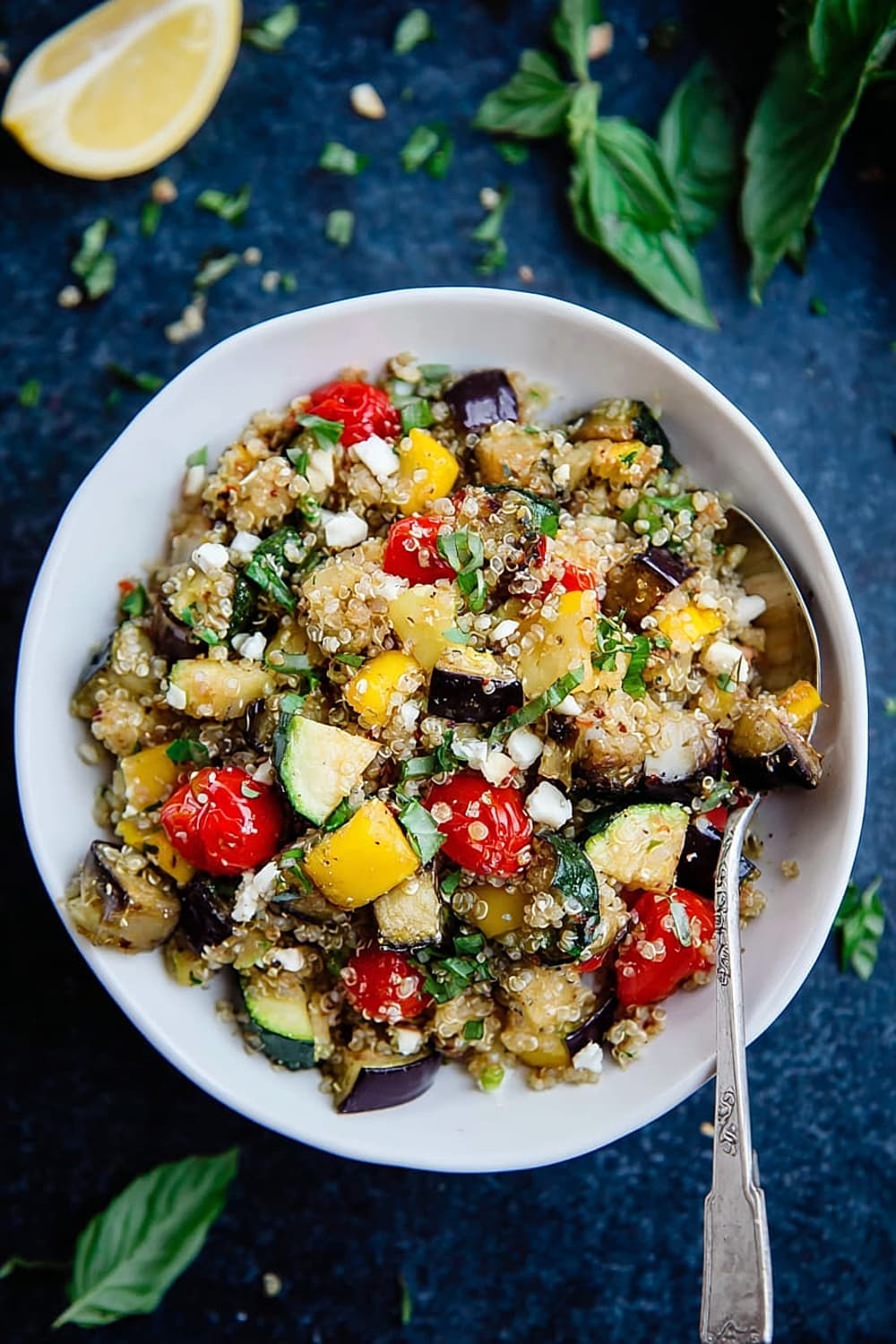
This Mediterranean quinoa salad is basically the overachiever of the salad world – it looks fancy enough for dinner parties but is actually foolproof enough for your Tuesday night “what’s for dinner” panic.
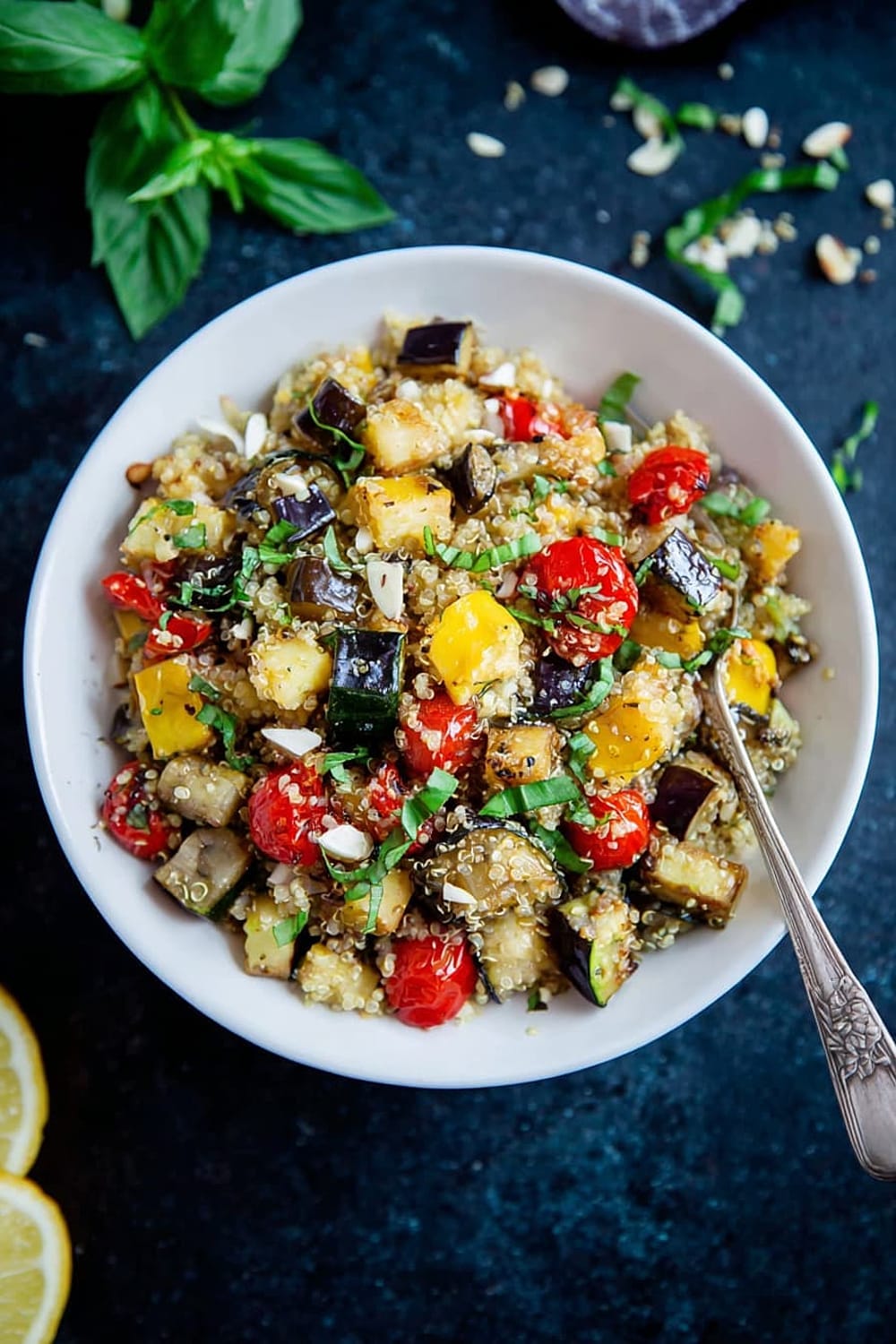
Picture this: golden roasted vegetables that smell like summer vacation, fluffy quinoa that actually tastes like something, and fresh herbs that make your kitchen smell like a Mediterranean garden center.
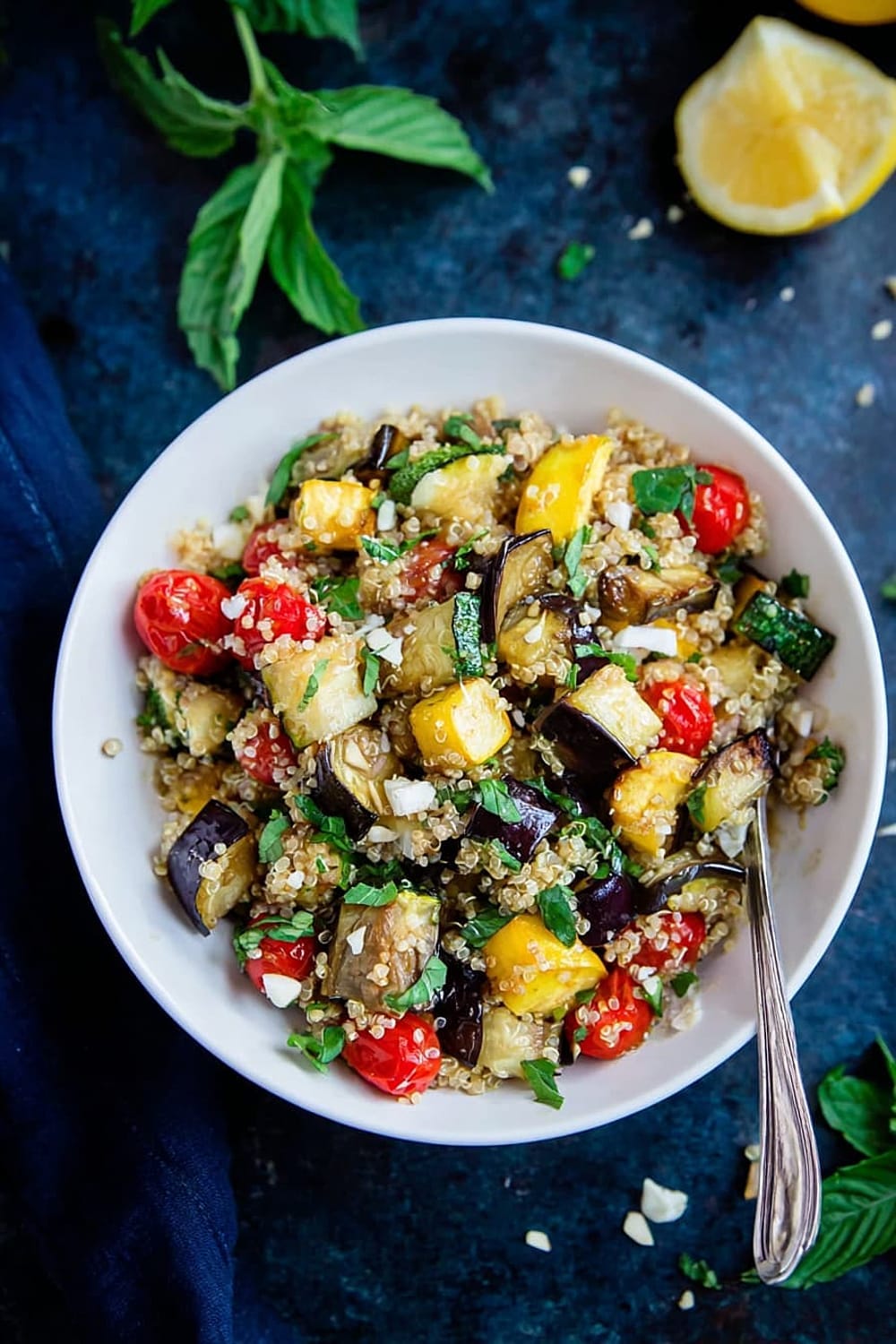
The secret weapon here is roasting those vegetables until they’re caramelized and slightly crispy on the edges – none of that sad, steamed vegetable nonsense that makes people hate healthy food.
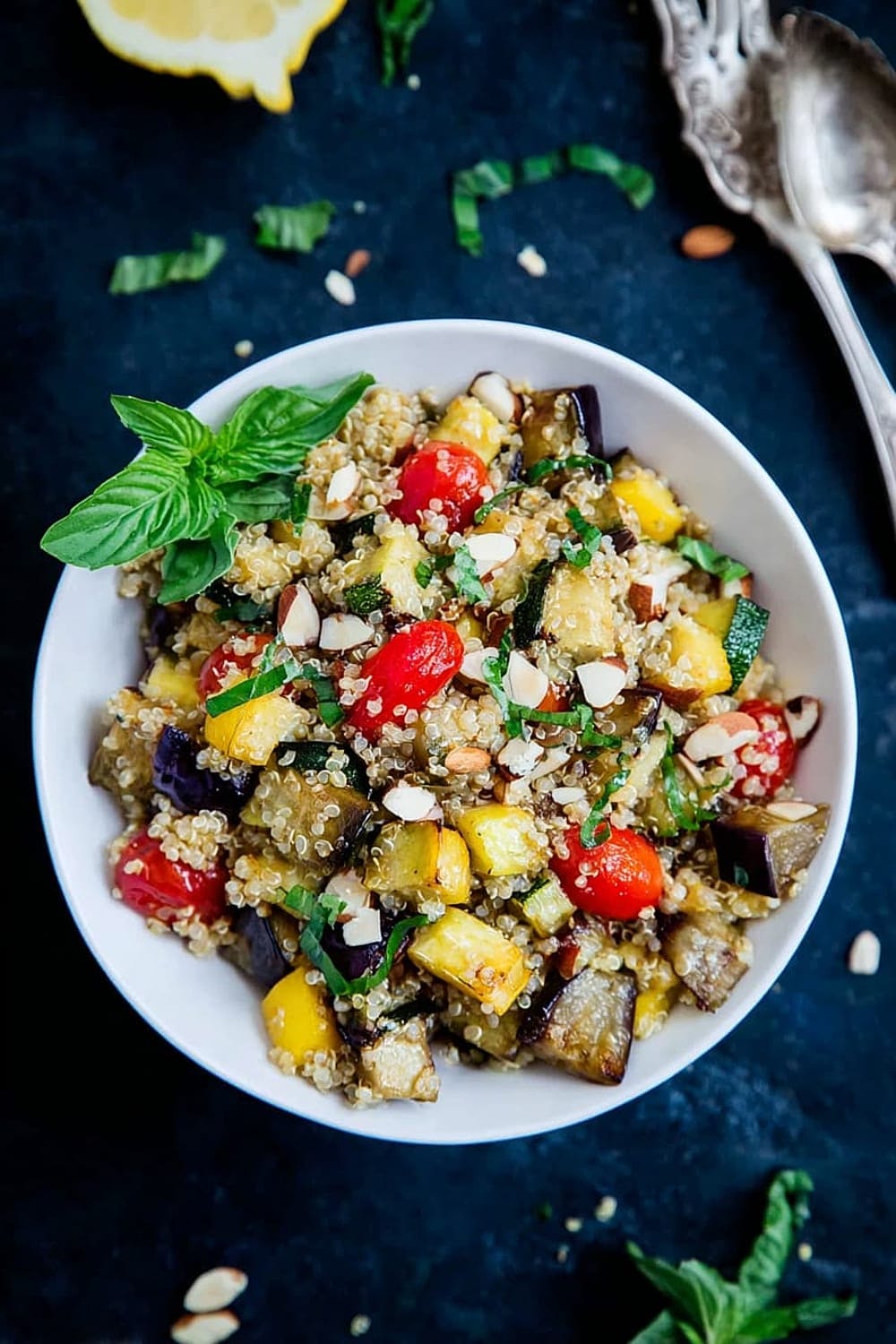
This is the kind of recipe that makes people assume you’re one of those organized humans who meal preps on Sundays and has matching storage containers.
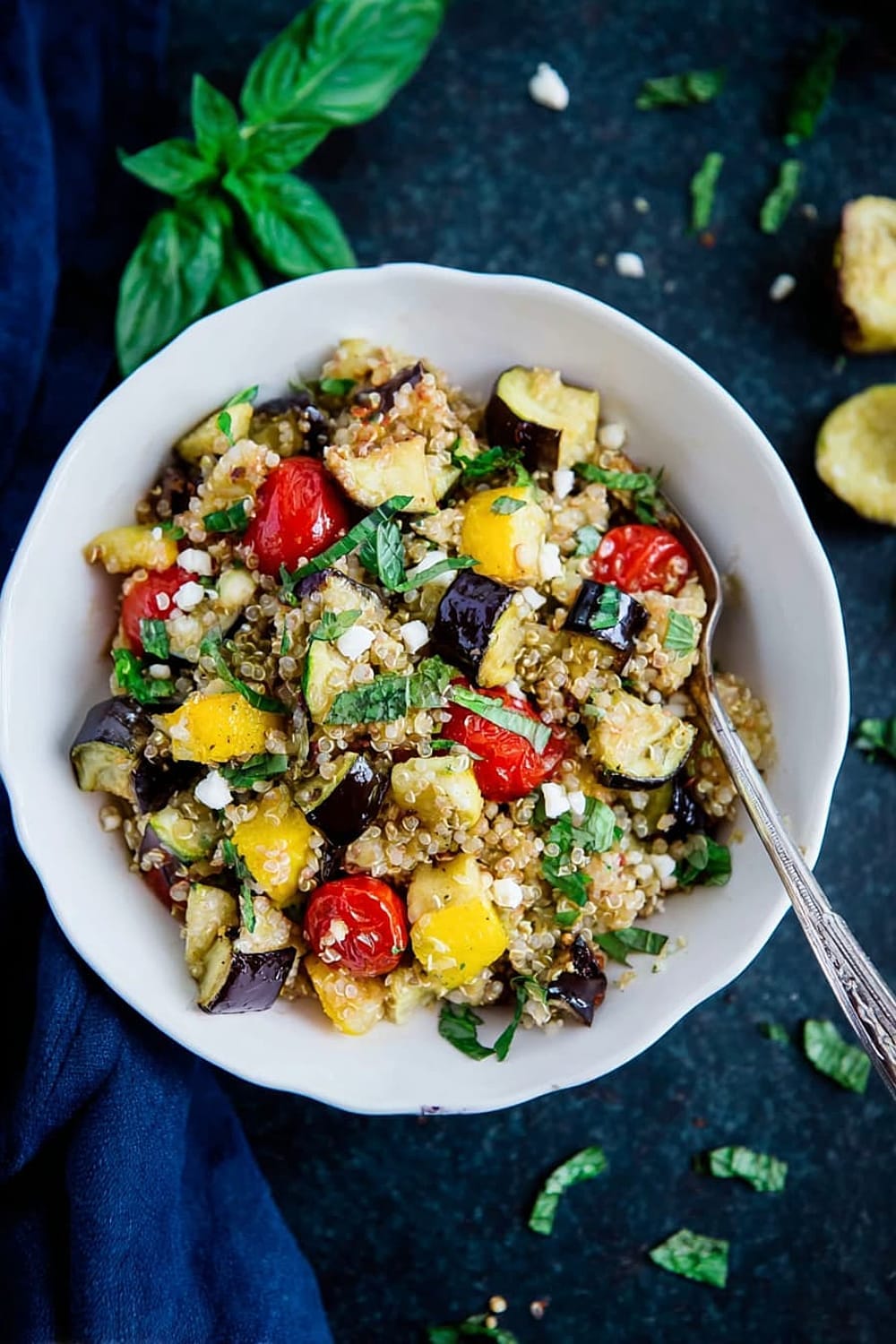
The best part is that it tastes even better the next day, which means you can make it ahead and pretend you’re not frantically throwing dinner together at the last minute.
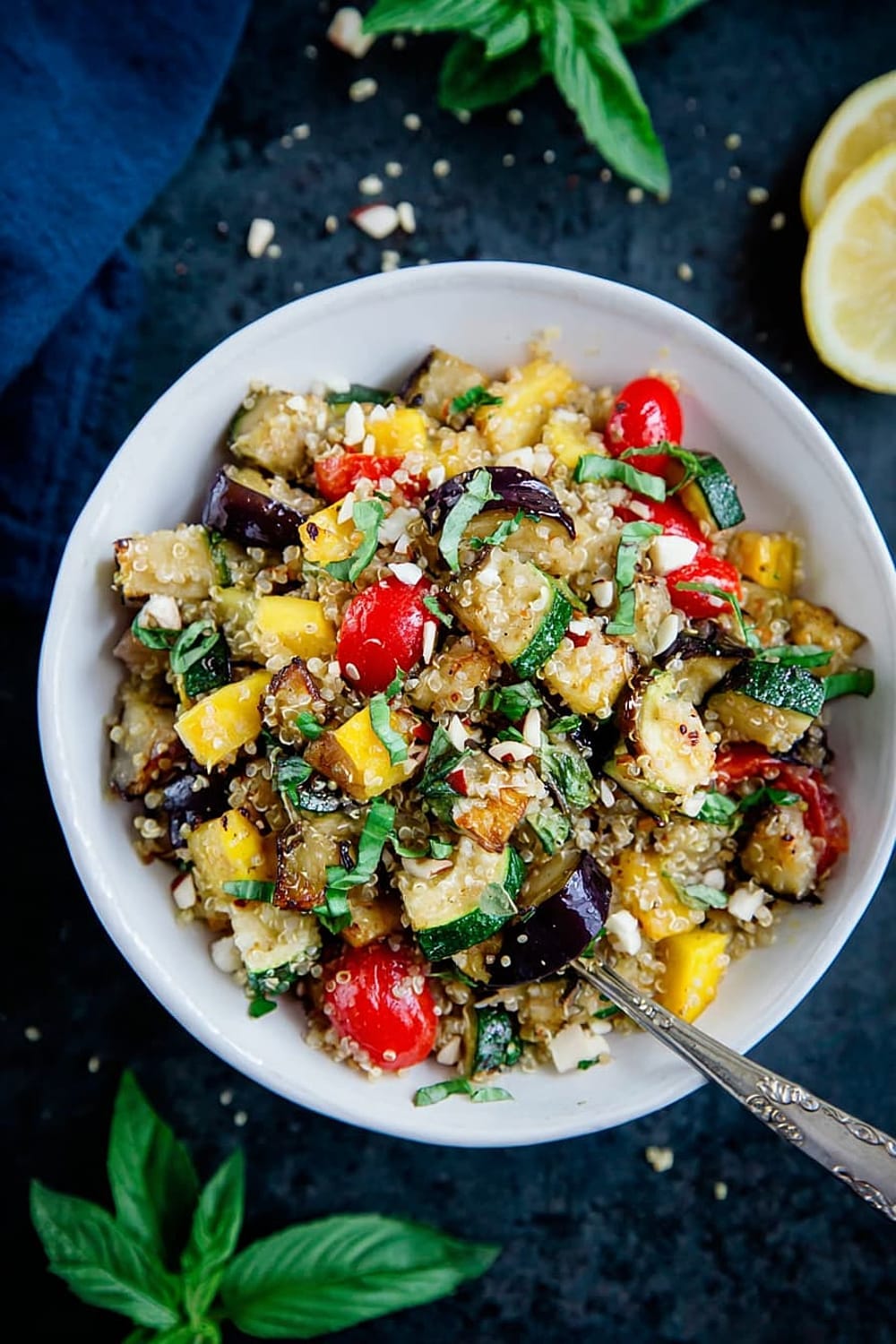
Warning: making this will result in people asking for the recipe, and you’ll have to decide whether to share your secret or let them think you’re just naturally gifted at the whole “eating like a grown-up” thing.
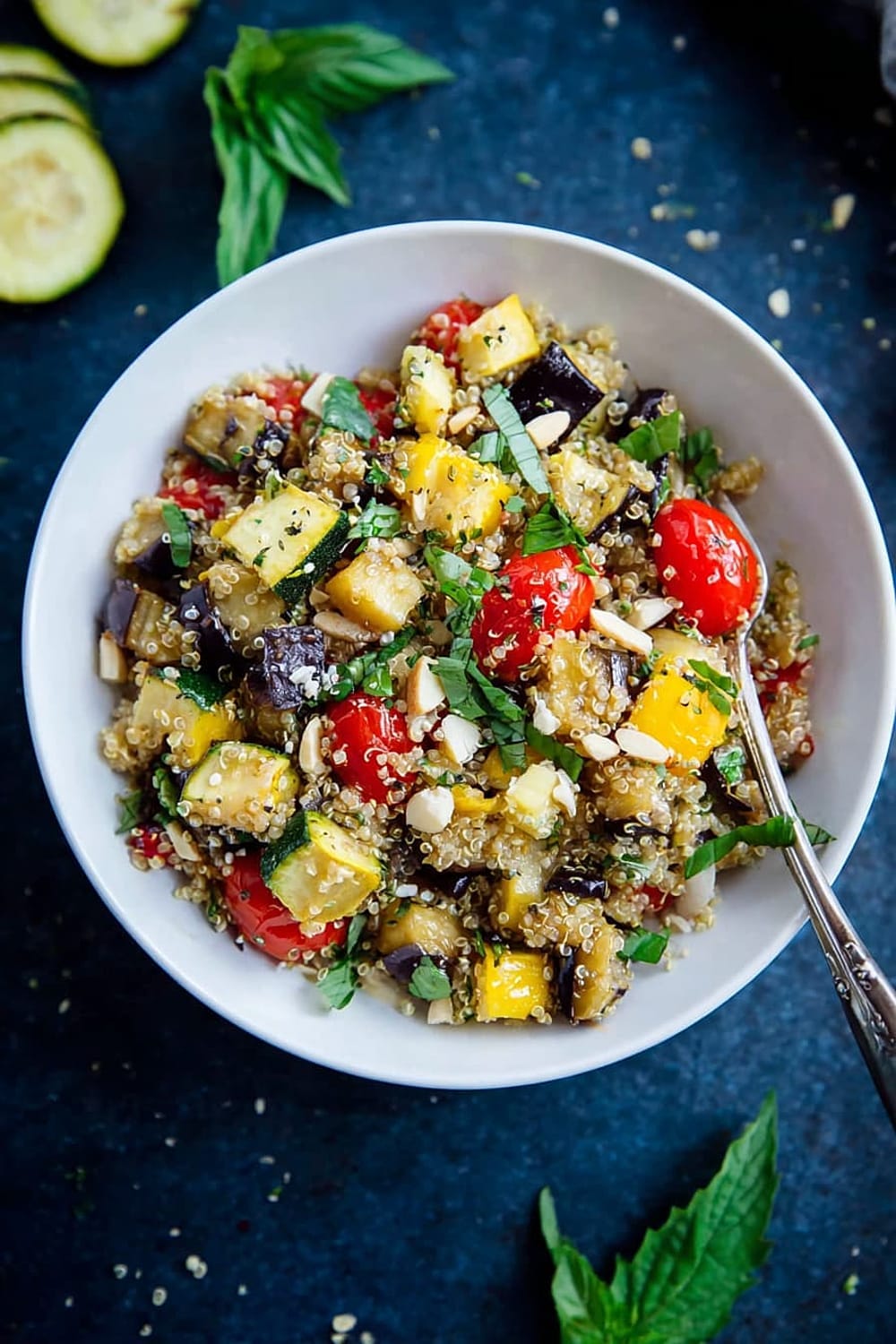
Ingredients
For the Roasted Vegetables
- 1 medium eggplant (about 1 pound), diced
- 1 medium-to-large zucchini, diced
- 1 medium-to-large yellow squash (or another zucchini), diced
- 4 tablespoons olive oil, divided
- Salt and freshly ground black pepper
For the Quinoa Base
- ½ cup uncooked quinoa, rinsed (or 1 ½ cups cooked quinoa)
- 1 cup water
For the Dressing and Assembly
- 2 to 3 tablespoons lemon juice, to taste (about 1 medium lemon)
- 1 clove garlic, pressed or minced
- 1 cup halved grape tomatoes (quarter any larger tomatoes)
- ⅔ ounce fresh basil leaves, chopped (about ⅓ cup)
- ⅔ ounce fresh mint leaves, chopped (about ⅓ cup)
- ¼ cup sliced almonds or pine nuts, toasted
- ½ cup crumbled feta cheese, optional
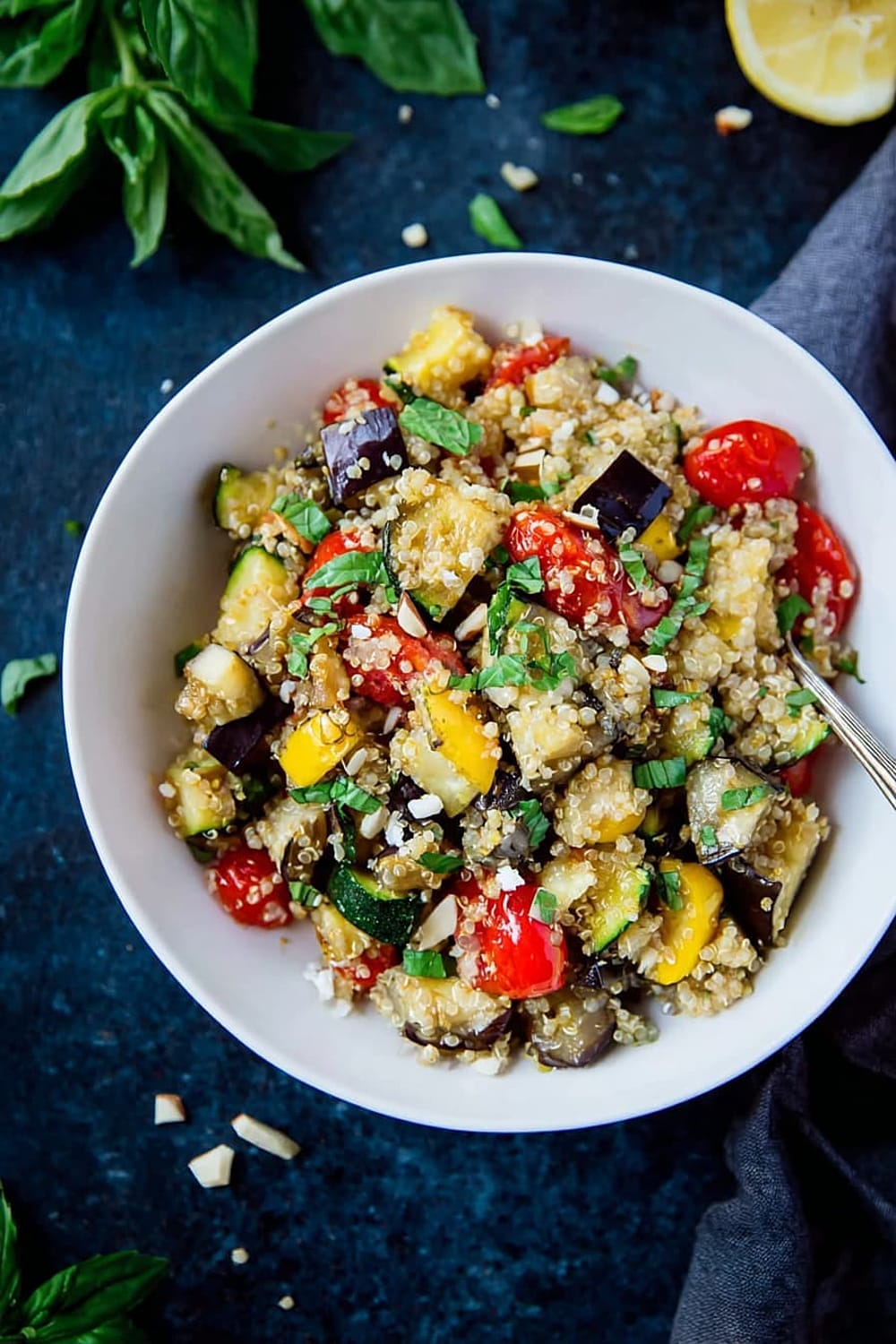
Instructions
Preparation
- 1 Preheat oven to 425°F (220°C) with racks in the upper and lower thirds of the oven. Line two large, rimmed baking sheets with parchment paper. Using parchment paper prevents sticking and makes cleanup effortless, plus it helps achieve even browning without burning.
- 2 Divide the eggplant, zucchini and yellow squash between the two baking sheets. Don’t overcrowd the vegetables – they need space to roast properly rather than steam. Drizzle each baking sheet with 1 tablespoon olive oil and toss with your hands or tongs until every piece is lightly coated. Add a little more oil if necessary; you want enough to lightly coat all the vegetables for optimal caramelization.
Roasting the Vegetables
- 3 Sprinkle each pan with ¼ teaspoon salt and 5 twists of pepper. The salt draws out moisture initially, then helps create those beautiful caramelized edges we’re after. Roast until the vegetables are softened and browning along the edges, about 25 to 30 minutes. You’ll know they’re done when the eggplant is tender when pierced with a fork and the squash has golden-brown edges.
- 4 Set the roasted vegetables aside to cool while you prepare the other components. This cooling time allows the flavors to concentrate and prevents the hot vegetables from wilting the fresh herbs later.
Cooking the Quinoa
- 5 To cook the quinoa, combine the uncooked quinoa with 1 cup water in a small saucepan. The key to fluffy quinoa is using the right water-to-quinoa ratio and not lifting the lid during cooking. Bring to boil over medium-high heat, then cover and reduce heat to low.
- 6 Simmer until the water is absorbed, about 15 minutes. You’ll hear the bubbling slow down significantly when it’s ready. Remove from heat and let the quinoa steam with the lid on for 5 minutes – this step is crucial for achieving the perfect texture.
- 7 Remove lid, fluff the quinoa with a fork to separate the grains, and set aside to cool slightly. Properly cooked quinoa should be tender but still have a slight bite, never mushy.
Toasting the Nuts
- 8 To toast the almonds or pine nuts, cook them in a small skillet over medium heat, stirring frequently, until they’re turning lightly golden and fragrant, about 4 to 8 minutes. Pine nuts toast faster than almonds, so watch carefully. The nuts are done when they smell nutty and have golden spots.
Final Assembly
- 9 In a large serving bowl, whisk together 2 tablespoons of the lemon juice and garlic using a wire whisk or fork. Slowly pour in the remaining 2 tablespoons of olive oil while whisking constantly to create a proper emulsion. This technique ensures the dressing won’t separate.
- 10 Add the tomatoes, quinoa, basil, mint, roasted vegetables and toasted nuts, and gently stir to combine using a large spoon or silicone spatula. Be gentle to avoid mashing the roasted vegetables or bruising the herbs.
- 11 Season generously with salt (start with another ¼ teaspoon or more), pepper and maybe another squeeze of lemon, to taste. The salad should taste bright and well-seasoned. Stir in the crumbled feta cheese if using. Serve at room temperature for the best flavor development. Store in an airtight container in the refrigerator for up to 5 days.
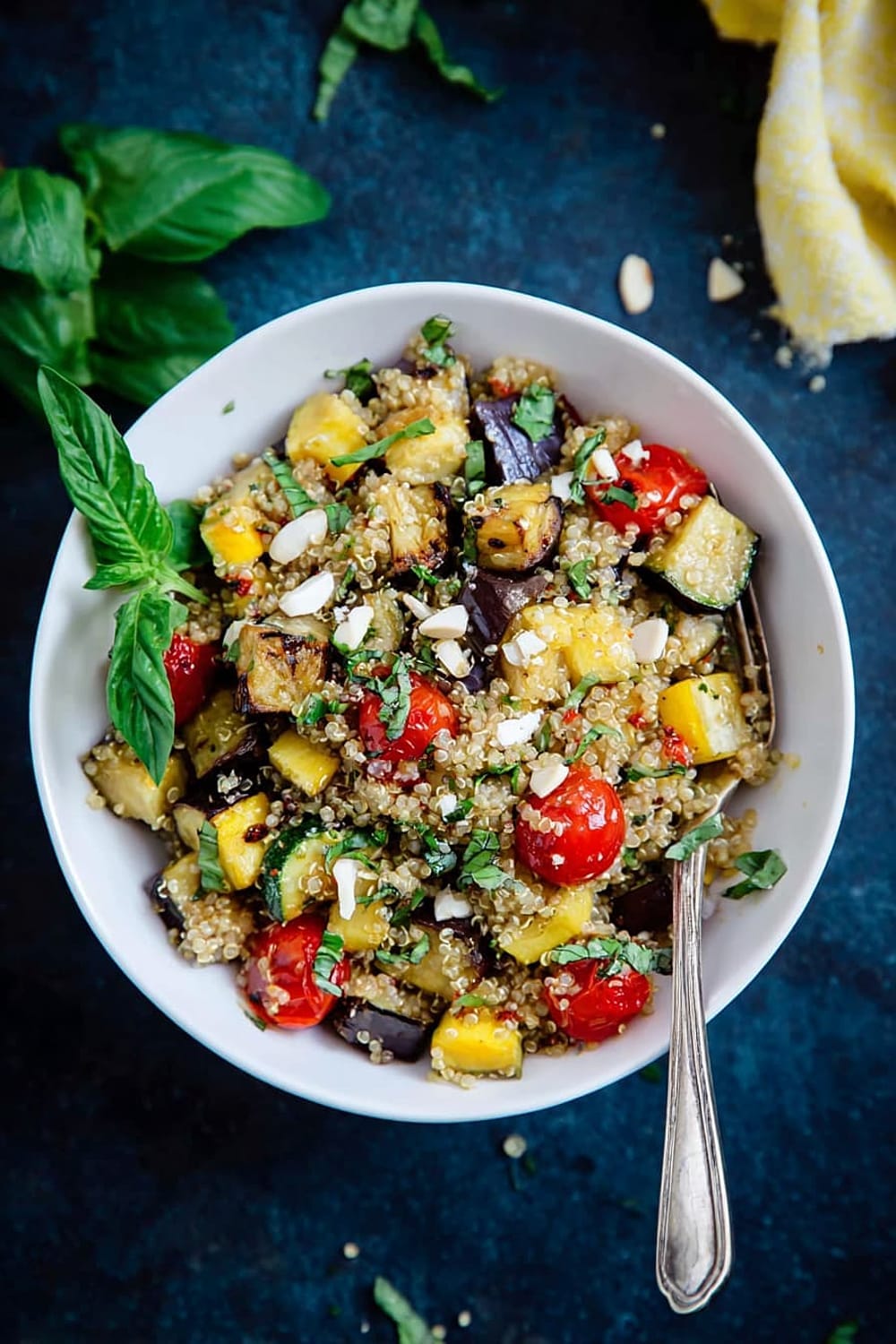
Recommended Equipment and Kitchen Tools
Recommended Tools (for best results):
- Large rimmed baking sheets – Essential for proper roasting without vegetables rolling off the edges. The rimmed edges contain the olive oil and prevent dripping in your oven
- Parchment paper – Creates a non-stick surface and promotes even browning while making cleanup effortless
- Small saucepan with tight-fitting lid – Critical for cooking quinoa properly using the absorption method
- Wire whisk – Helps create a proper emulsion when making the lemon-olive oil dressing
Helpful Upgrades:
- Kitchen scale – For precise measurements, especially helpful when portioning vegetables evenly between baking sheets
- Microplane grater – Makes quick work of zesting lemons and mincing garlic to a fine paste
- Cast iron skillet – Superior heat retention for toasting nuts evenly without hot spots
- Large mixing bowls – Having multiple sizes makes ingredient prep and assembly much more organized
Nice-to-Have Options:
- Silicone spatula – Gentle on roasted vegetables and perfect for folding ingredients without breaking them apart
- Instant-read thermometer – While not essential, helps ensure your oven is actually at the right temperature for optimal roasting
- Storage containers – Glass containers with tight-fitting lids keep this salad fresh for meal prep throughout the week

Recipe Variations and Dietary Modifications
Gluten-Free Adaptation:
- This recipe is naturally gluten-free as written, making it perfect for those with celiac disease or gluten sensitivity
- Always check that your feta cheese is certified gluten-free, as some brands may contain additives
- Quinoa provides complete protein and has a satisfying, grain-like texture without any gluten concerns
Dairy-Free Modifications:
- Simply omit the feta cheese or substitute with ½ cup dairy-free feta alternative
- Add 2 tablespoons nutritional yeast for extra umami flavor to replace the salty, tangy notes from feta
- Increase the lemon juice by 1 tablespoon to compensate for the lost acidity from the cheese
Vegan Modifications:
- Follow the dairy-free modifications above
- Add ¼ cup hemp seeds or pumpkin seeds for extra protein and healthy fats
- Include 1 tablespoon tahini whisked into the dressing for added richness and Mediterranean flavor
Low-Carb Version:
- Replace quinoa with 2 cups cauliflower rice, lightly sautéed until tender
- Increase the roasted vegetables by adding 1 cup diced bell peppers or mushrooms
- Double the nuts and seeds for healthy fats and protein
Flavor Variations:
- Greek-style: Add kalamata olives, red onion, and oregano instead of mint
- Moroccan twist: Include dried apricots, cinnamon, and pistachios
- Italian influence: Swap herbs for fresh oregano and add sun-dried tomatoes
- Protein boost: Add chickpeas, grilled chicken, or hard-boiled eggs
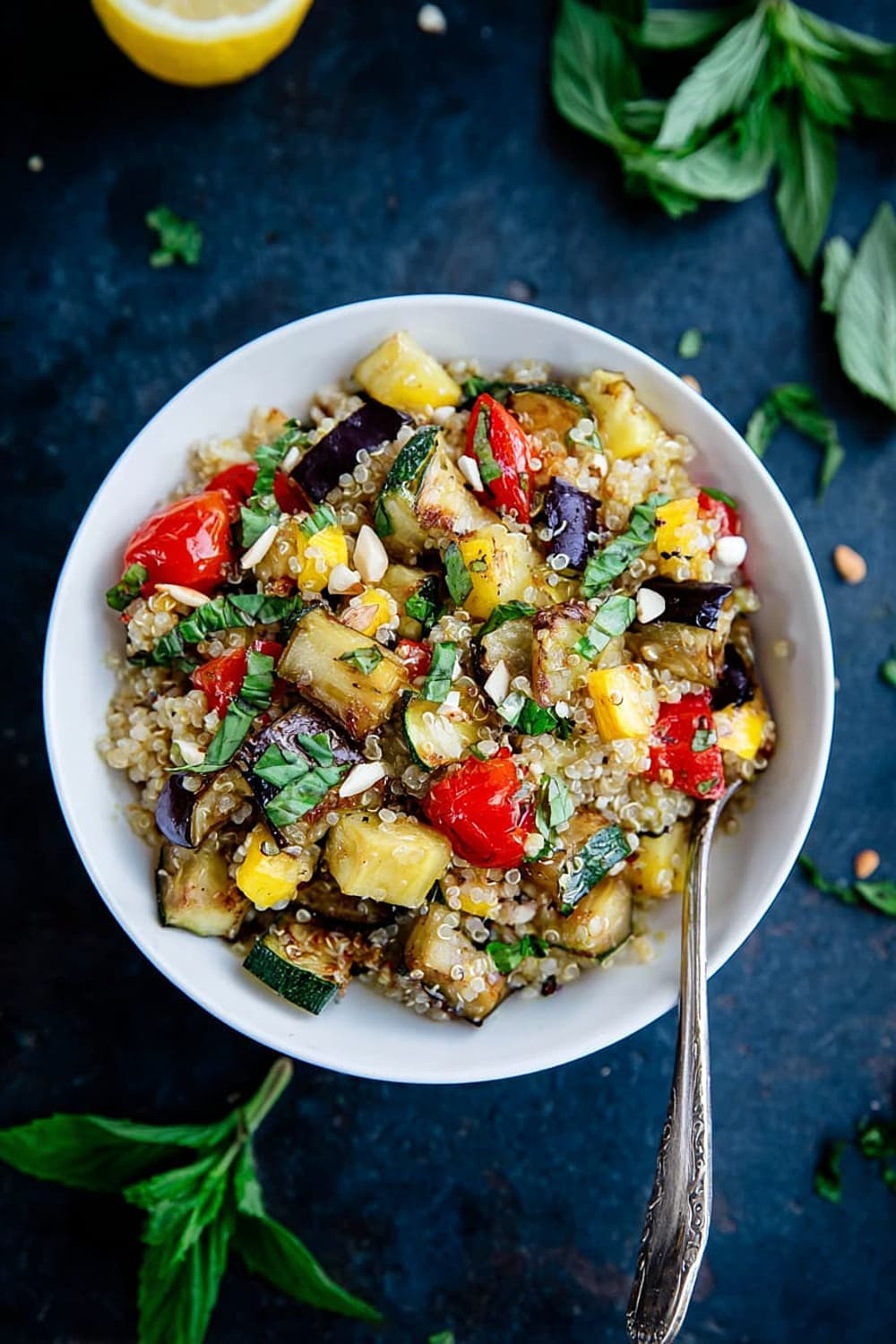
Nutritional Information and Health Benefits
Key Nutritional Highlights:
This Mediterranean quinoa salad provides approximately 285 calories per serving when divided into 6 portions, with a balanced macronutrient profile of complex carbohydrates, healthy fats, and complete protein. The quinoa contributes all nine essential amino acids, making this a complete protein source perfect for vegetarians. Each serving delivers about 8 grams of fiber from the quinoa and vegetables, supporting digestive health and helping maintain stable blood sugar levels.
Health Benefits of Main Ingredients:
The roasted eggplant provides powerful antioxidants called anthocyanins, which give it that beautiful purple color and help protect against cellular damage. Zucchini and yellow squash are excellent sources of vitamin C and potassium while being naturally low in calories and high in water content. The fresh herbs – basil and mint – contain volatile oils with anti-inflammatory properties and provide vitamin K for bone health. Extra virgin olive oil delivers heart-healthy monounsaturated fats and vitamin E, while the nuts add protein, healthy fats, and vitamin E.
Dietary Considerations:
This recipe is naturally vegetarian and can easily be made vegan by omitting the feta cheese. It’s gluten-free, making it suitable for those with celiac disease or gluten sensitivity. The combination of quinoa and vegetables provides sustained energy without blood sugar spikes, making it diabetes-friendly when portion sizes are monitored. Each serving contains approximately 12 grams of plant-based protein, making it a satisfying meal that supports muscle maintenance and satiety.
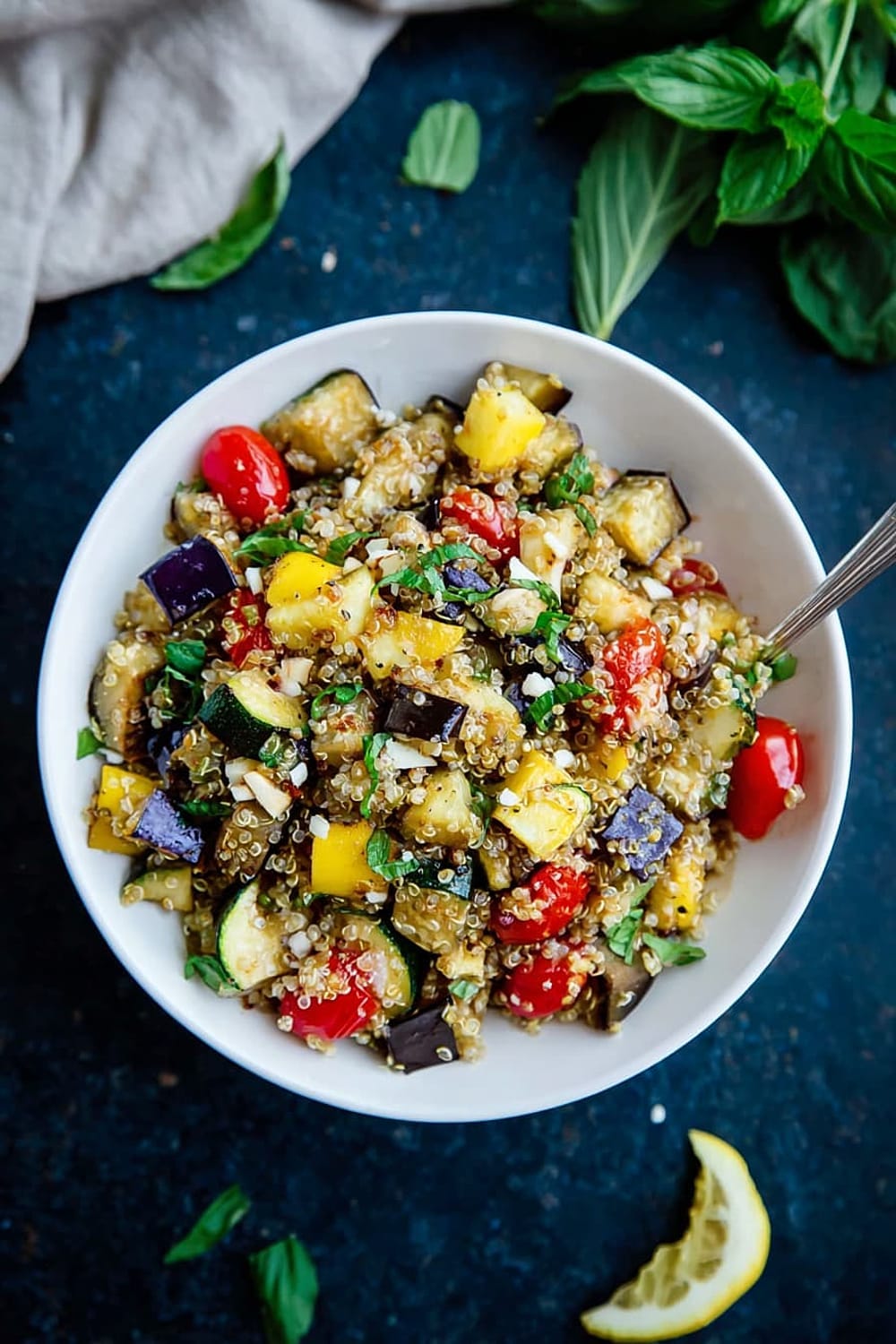
Smart Swaps and Ingredient Substitutions
Common Substitutions:
- Quinoa → Brown rice, farro, or bulgur wheat (adjust cooking times accordingly)
- Eggplant → Bell peppers, mushrooms, or additional zucchini if you dislike eggplant’s texture
- Fresh herbs → 1 tablespoon dried herbs (use less since dried herbs are more concentrated)
- Feta cheese → Goat cheese, ricotta salata, or dairy-free cheese alternatives
Budget-Friendly Swaps:
- Pine nuts → Sunflower seeds, pumpkin seeds, or chopped walnuts (much more affordable)
- Fresh herbs → Frozen herbs or herb pastes from tubes (available year-round)
- Grape tomatoes → Regular tomatoes diced, or canned diced tomatoes (drained well)
- Extra virgin olive oil → Regular olive oil for roasting (save the good stuff for the dressing)
Pantry Emergency Substitutions:
- Fresh lemon juice → 2 tablespoons white wine vinegar or apple cider vinegar
- Fresh garlic → ¼ teaspoon garlic powder or granulated garlic
- Fresh mint → 1 teaspoon dried mint or additional basil
- Yellow squash → Additional zucchini, or even diced bell peppers
Pro Tips for Substitutions:
- When using dried herbs instead of fresh, add them during the roasting process so they bloom in the heat
- If substituting different grains for quinoa, adjust liquid ratios and cooking times according to package directions
- Frozen vegetables can work in a pinch – just thaw and pat dry before roasting to prevent excess moisture
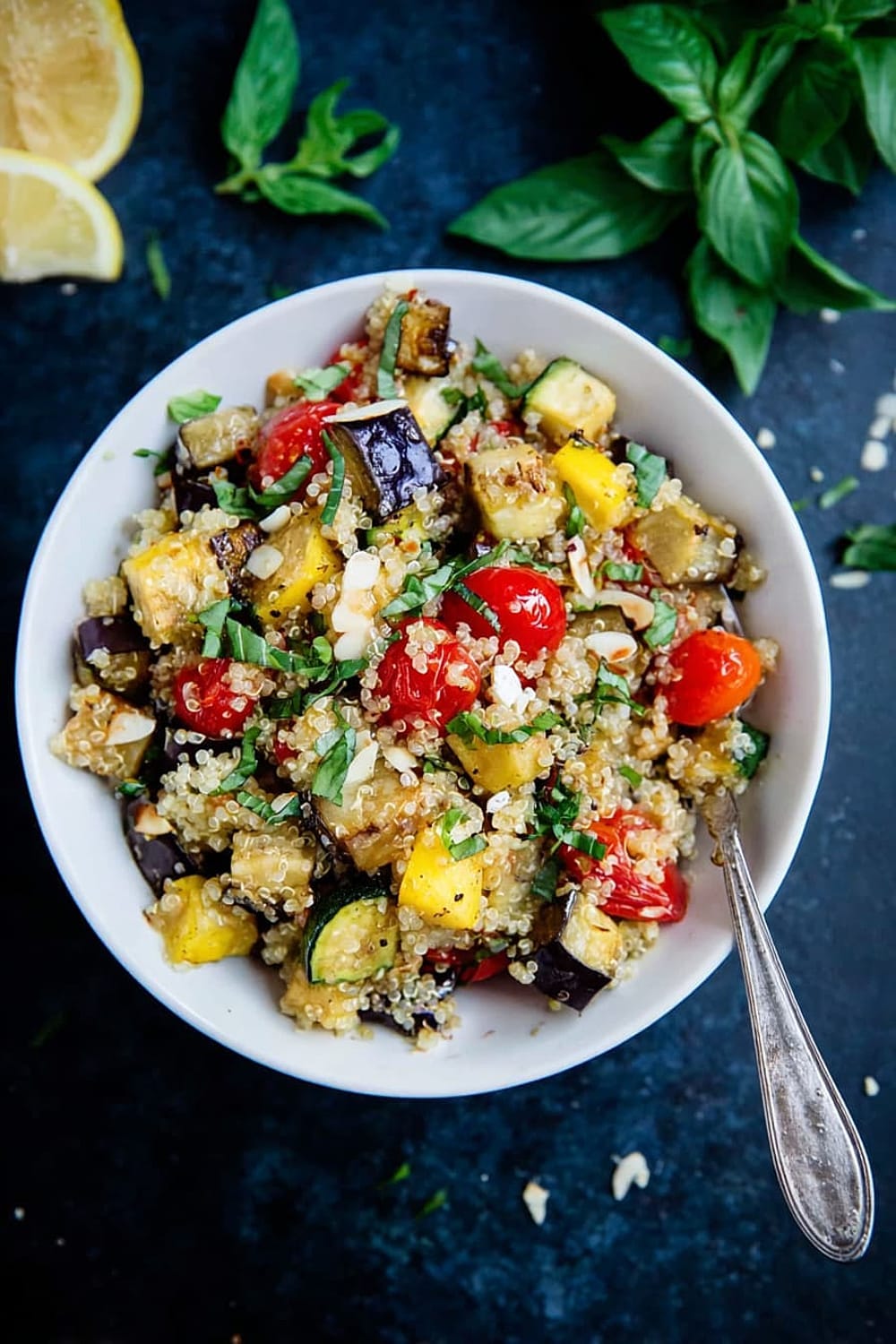
Make It Diabetes-Friendly
Carb Management Strategies:
- Reduce quinoa to ⅓ cup uncooked (yields about 1 cup cooked) to lower total carbohydrates per serving
- Increase vegetables by adding 1 cup diced bell peppers or mushrooms to maintain volume and satisfaction
- Add protein with ½ cup chickpeas or 4 oz grilled chicken to help stabilize blood sugar response
Portion & Timing Tips:
- Ideal serving size: 1 cup as a side dish or 1½ cups as a main course with added protein
- Estimated carbs per serving: Approximately 28 grams with full quinoa amount, 18 grams with reduced quinoa
- Pair with protein: Add grilled fish, chicken, or 2 tablespoons nuts to slow glucose absorption
Fiber & Fat Optimization:
- Double the nuts to ½ cup for added healthy fats and protein
- Include avocado: Add ½ diced avocado per serving for heart-healthy monounsaturated fats
- Extra vegetables: The high fiber content from roasted vegetables helps moderate blood sugar spikes
Total Carb Reduction: Modified version reduces carbohydrates by approximately 35% while maintaining flavor and satisfaction through increased vegetables and healthy fats.
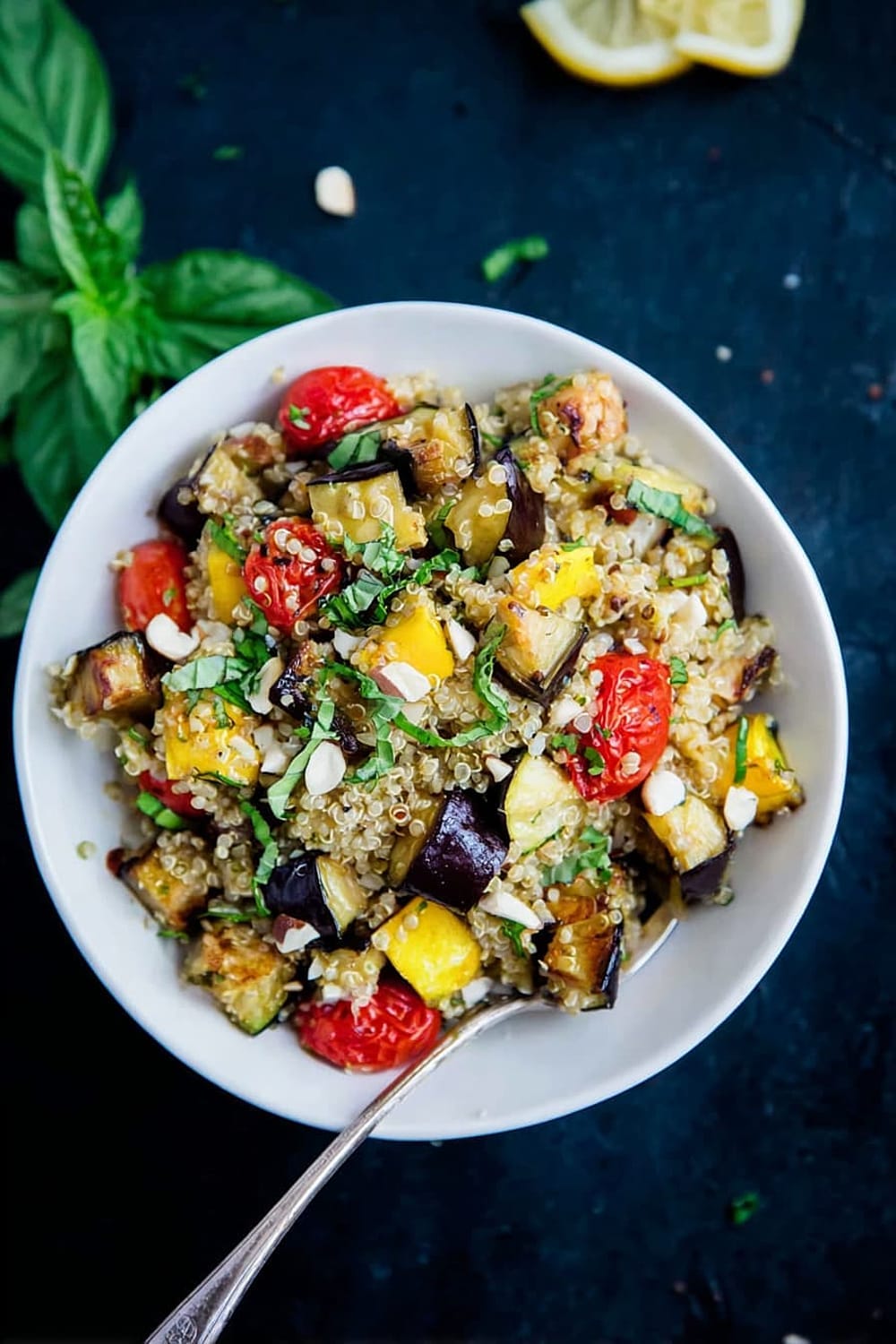
Perfect Pairing Suggestions
Beverage Pairings:
This bright, herbaceous salad pairs beautifully with crisp white wines like Sauvignon Blanc or Pinot Grigio, whose acidity complements the lemon dressing. For red wine lovers, a light Côtes du Rhône or Chianti works wonderfully with the roasted vegetables. Non-alcoholic options include sparkling water with lemon and mint, iced green tea, or a refreshing cucumber-mint agua fresca that echoes the Mediterranean flavors.
Side Dish Recommendations:
Serve alongside grilled lamb or chicken for a complete Mediterranean feast, or pair with warm pita bread and hummus for a vegetarian meal. The salad’s fresh flavors complement rich dishes like moussaka or spanakopita beautifully. For a lighter approach, serve with grilled fish like branzino or salmon, or alongside other mezze dishes like dolmas, tapenade, and marinated olives.
Complete Meal Ideas:
Create an impressive Mediterranean spread by serving this as the centerpiece alongside grilled halloumi, warm flatbread, and a selection of olives and roasted red peppers. For casual entertaining, pair with grilled vegetables and your favorite protein. The salad works beautifully as part of a potluck spread or picnic menu since it travels well and tastes great at room temperature.
Occasion Suggestions:
Perfect for summer barbecues, potluck dinners, and meal prep sessions. The make-ahead friendly nature makes it ideal for busy weeknight dinners or Sunday meal prep. It’s elegant enough for dinner parties yet casual enough for family meals, and the colorful presentation makes it Instagram-worthy for those special occasions when you want to show off your cooking skills.
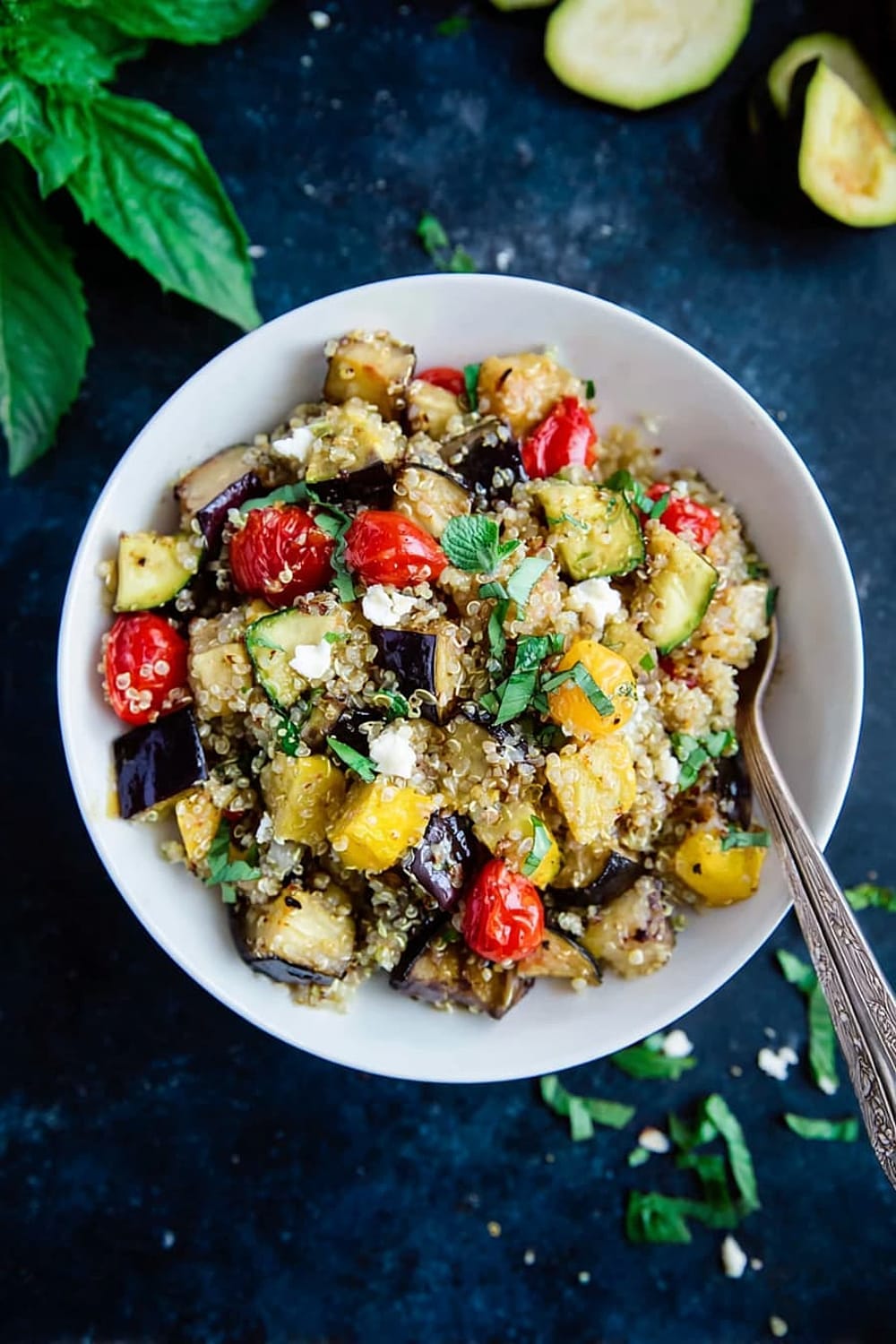
Pro Tips and Troubleshooting
Professional Roasting Techniques:
Cut vegetables into uniform ¾-inch pieces for even cooking – smaller pieces burn while larger pieces stay raw. Don’t skip the cooling time for roasted vegetables; adding hot vegetables will wilt the fresh herbs and make the salad soggy. For maximum flavor development, let the assembled salad sit for 30 minutes before serving to allow the dressing to penetrate all ingredients.
Common Mistakes and Solutions:
Overcrowding the baking sheets leads to steaming instead of roasting – use two sheets and give vegetables space to breathe. If your quinoa turns out mushy, you’ve either used too much water or cooked it too long; next time, use a 1:2 ratio and don’t lift the lid during cooking. Underseasoned salads are disappointing – taste and adjust salt, pepper, and lemon juice until the flavors pop.
Storage and Make-Ahead Strategies:
This salad actually improves overnight as flavors meld together. Store in the refrigerator for up to 5 days in an airtight container. Add fresh herbs and a squeeze of lemon just before serving if the salad has been stored for more than 2 days. The components can be prepped separately and assembled just before serving for maximum freshness.
Scaling and Presentation Tips:
Double or triple the recipe easily for crowd feeding – just use additional baking sheets and rotate their positions halfway through roasting. For elegant presentation, arrange on a large platter and garnish with extra herbs and a drizzle of good olive oil. Serve in individual bowls for formal dinners, or family-style in a large wooden bowl for casual gatherings.
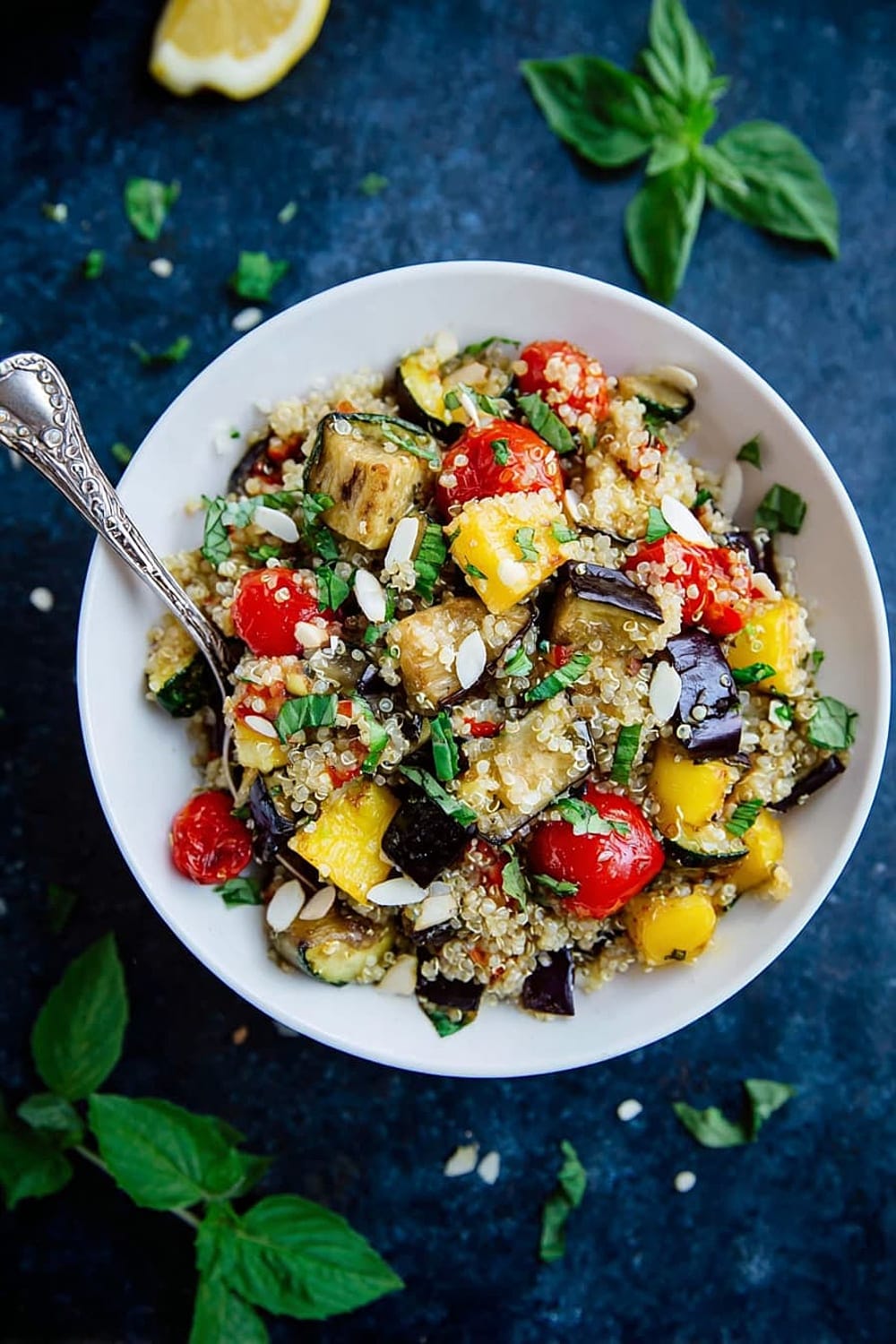
This Mediterranean quinoa salad proves that healthy eating doesn’t have to be boring or complicated. With its combination of perfectly roasted vegetables, fluffy quinoa, and bright fresh herbs, it’s the kind of recipe that makes you feel good about what you’re eating while actually enjoying every bite. Whether you’re meal prepping for the week or impressing dinner guests, this versatile salad delivers on both nutrition and flavor, making it a true winner in any home cook’s repertoire.